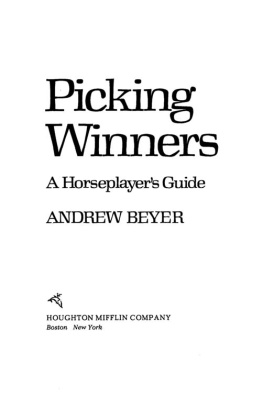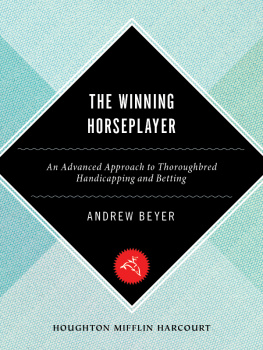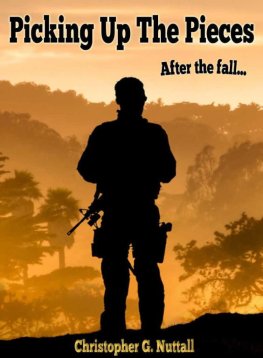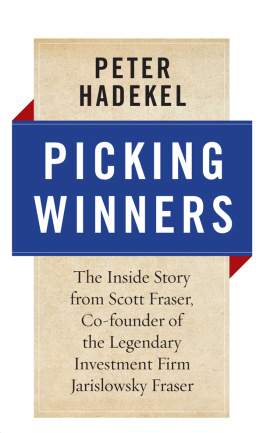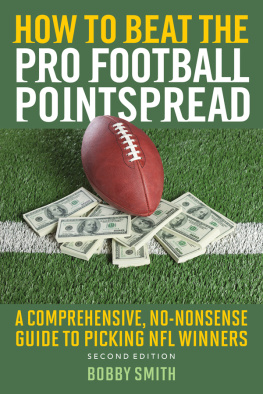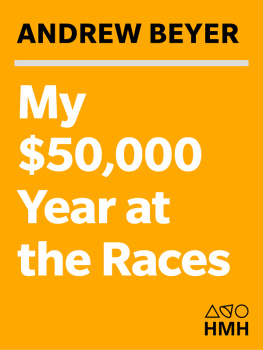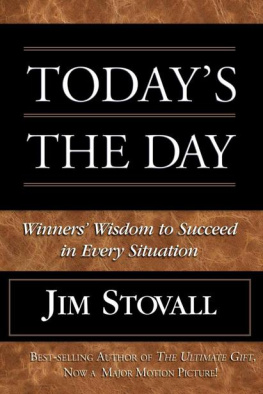To my mother
Copyright 1975, 1985, 1994 by Andrew Beyer
All rights reserved
For information about permission to reproduce selections from this book, write to Permissions, Houghton Mifflin Company, 215 Park Avenue South, New York, New York 10003.
Library of Congress Cataloging in Publication Data
Beyer, Andrew.
Picking winners.
1. Horse race betting. I. Title.
SF331.B45 798'.401 74-34311
ISBN 0-395-70132-5 (pbk.)
ISBN 978-0-395-70132-4 (pbk.)
Printed in the United States of America
DOC 30 29 28 27 26
The charts appearing on of this book are reprinted by special arrangement with Triangle Publications, Inc. (Daily Racing Form). Copyright 1972, 1973, 1974 by Triangle Publications, Inc. Reprinted with permission of the copyright owner.
Foreword
S EVENTEEN YEARS AFTER the original publication of Picking Winners, the methods in this book received their ultimate vindication. In April 1992, the Daily Racing Form began to include Beyer Speed Figures in the record of every racehorse in North America. Casual horseplayers became speed handicappers and regularly based betting decisions on these figures, which translate each previous performance of a horse into a numerical rating. Handicappers writing for the Racing Form also acknowledged the importance of speed figures, making comments such as this: "Beyer Boys will form flying wedge to betting windows to play this standout." Even owners, trainers, and breeders started to define their horses in terms of figures. An advertisement for the stallion Housebuster listed his career victories according to the speed figures that he had earned.
To anyone who has become interested in horse racing in recent years, this keen awareness of horses' speed may seem unremarkable. Surely it doesn't require much imagination to conclude that races will often be won by the fastest horse. Yet in 1975, this idea was considered heterodox, even preposterous. Horseplayers believed in class, not speed, and experts would frequently pose a hypothetical question like this one: A $10,000 horse runs six furlongs in 1:11. A $20,000 horse runs the same distance in l:ll. Now they are matched against each other; who will win? The overwhelming majority of people involved in American racing would have answered without hesitation that the $20,000 animal's superior class would enable him to prevail. Even Tom Ainslie, the most astute and literate author of handicapping books, espoused the supreme importance of class.
Of course, there were in America some bettors who recognized the importance of speed and profited handsomely by betting on the $10,000 horse who could run faster than his $20,000 rival. In the 1950s, the handicapper Jules Fink and his associates enjoyed legendary success at the betting windows and became known as the Speed Boys. A gambler named Harry Ragozin hired a statistician to help him analyze the times of races; his son, Len, would later sell figures based on his father's methods to a coterie of trainers, owners, and high-rolling gamblers. So when I started experimenting with figures in the early 1970s, and was exhilarated to learn that I could make a profit with them, I was merely reinventing the wheel.
But unlike other gamblers who were understandably close-mouthed about their successful methods, I was also a journalist, and I wanted to write a book about horse racing. While I was an undergraduate at Harvard, the most widely read book of my generation was not The Iliad or Hamlet, but The Education of a Poker Player, by Herbert O. Yardley, which combined sound, sophisticated strategy for the game with wonderful stories depicting the unique characters who populated the world of high-stakes poker. It made the reader want to hop on the nearest riverboat. Even as a college student I had envisioned writing a book that would do the same for horse-race betting, but then, of course, I was still learning the fundamentals of the game. But after discovering the usefulness of speed figures, I had the basis for a possible book, and when a former classmate became an editor at Houghton Mifflin, I had the opportunity to write Picking Winners.
The book made the intellectual case for speed handicapping but, even so, I thought that only a handful of readers would be willing to wade through the complicated chapters that form its core and then devote the considerable time and effort necessary to calculate a set of figures. Yet the racing world was filled with a surprising number of bettors who were ready and eager to do whatever was necessary to succeed at the track; they needed only to be shown the way. And as the computer era was dawning, more and more people with a mathematical bent were attracted by the idea of using numerical methods to analyze this complex game. When an increasing number of bettors recognized the great usefulness of figures, speed handicapping finally received wide acceptance, culminating with the Daily Racing Form's inclusion of them.
With speed figures now so accessible, most horseplayers will conclude that there is little need to grapple with the complexities involved in making their ownjust as students armed with calculators don't need to worry about the basics of arithmetic. But it will be a pity if making figures becomes a lost art, because the process can be an exciting one. It is also important for bettors who use the Beyer Speed Figures in the Racing Form to understand what the numbers mean and how they are made. Too many readers want to view the published figures as holy writ, when in fact many speed figures may be tinged with ambiguity and will involve a good deal of subjective judgment by the person who calculates them.
The method of making figures that I explain in Picking Winners has changed very little over the years. The basic speed-rating charts have been revised, and the ones I now use appear in the Appendix, along with par figures for various tracks. But the principles behind them are the same.
And, surprisingly, in a game that has undergone so many profound changes, much of the rest of Picking Winners has stood the test of time, tooparticularly the chapters on track bias, trainer patterns, and physical appearance. (Although these concepts now are viewed as fundamental subjects of handicapping, they had been ignored in racing literature before Picking Winners.) But there were at least two subjects whose importance I did not recognize in 1975: pace and trips.
In the original edition of Picking Winners, I had dismissed the importance of pace and declared that horses' performanceand their speed figureswere unaffected by the early fractions of a race. (To spare the reader from being misled and me from being embarrassed by my youthful ignorance, this short section has been expunged.) Nor had I begun to grasp the concept that the way a horse runs his racehis "trip"will affect his performance, and that a handicapper must watch and interpret races skillfully to judge a horse's ability fully. I devoted the better part of two subsequent books, The Winning Horseplayer (1983) and Beyer on Speed (1993), to this subject. But the central thrust of Picking Winners has remained relevant and highly effective because it deals with the most fundamental aspect of handicapping. As I quoted an old-time speed handicapper in 1975: "Time is the one immutable truth in the game." And immutable it remains.
1. The Joy of Handicapping
F ROM TIME TO TIME , every confirmed horseplayer is racked by doubts about what he is doing with his life. He is playing the toughest game in the world, one that demands a passionate, all-consuming dedication from anyone who seriously wants to be a winner. Even a winner will necessarily experience more frustrations than triumphs, and when the frustrations come in rapid succession he may wonder if the struggle is worth it.
Next page
